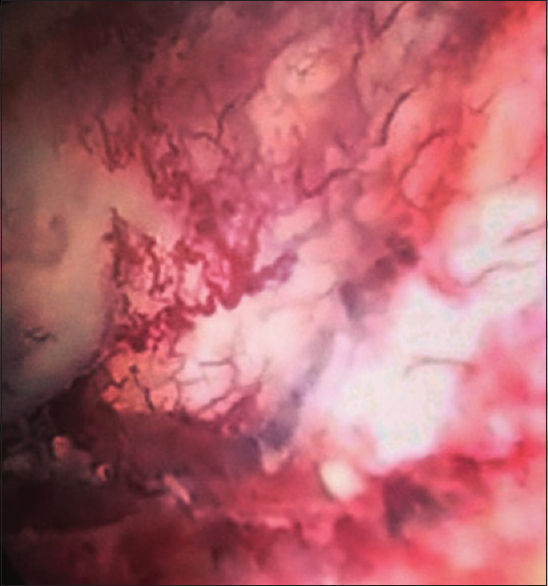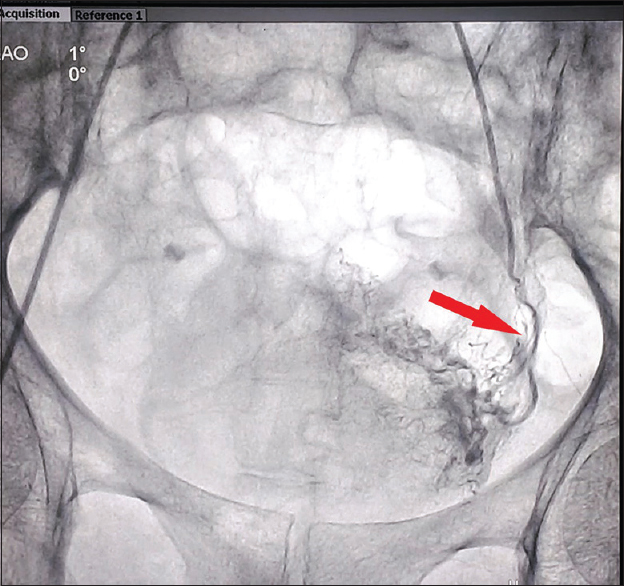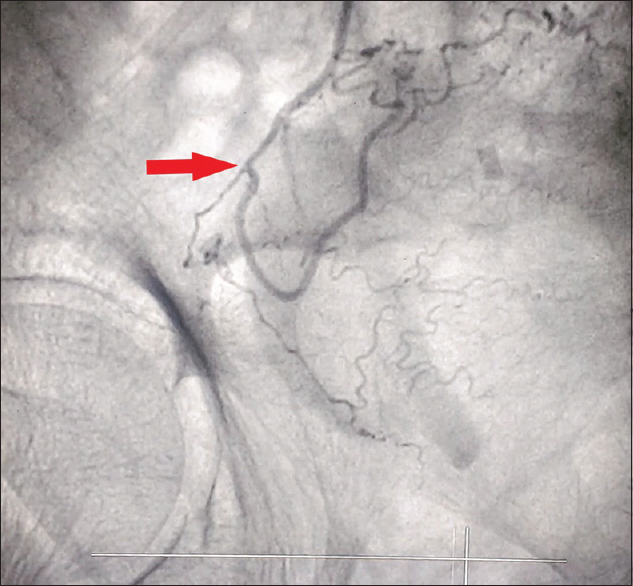Translate this page into:
Endovascular Management of Radiation-Induced Hemorrhagic Cystitis
Address for correspondence: Dr. Maureen P Tigga, 56 RMP Layout, Vijaynagar 4th Stage, Mysore, Karnataka, India. E-mail: maureentigga@gmail.com
This is an open access journal, and articles are distributed under the terms of the Creative Commons Attribution-NonCommercial-ShareAlike 4.0 License, which allows others to remix, tweak, and build upon the work non-commercially, as long as appropriate credit is given and the new creations are licensed under the identical terms.
This article was originally published by Wolters Kluwer - Medknow and was migrated to Scientific Scholar after the change of Publisher.
Abstract
Radiation-induced hemorrhagic cystitis (HC) is an unpleasant and sometimes life-threatening complication confronted while treating pelvic malignancies. A wide array of treatment modalities such as bladder irrigation, fulguration, hyperbaric oxygen therapy, and surgical methods has been proposed to treat hematuria, but there is no consensus on the optimal therapeutic strategy for the same. Reported here is a successful superselective embolization of the bilateral vesical arteries in a patient with refractory radiation-induced HC. This technique proved to be effective in controlling intractable hemorrhage and can be considered an option for the treatment of HC not amenable to conventional techniques.
Keywords
Cystoscopy
hemorrhagic cystitis
superselective embolization
vesical arteries
INTRODUCTION
Hemorrhagic cystitis (HC) is a challenging sequel of pelvic radiotherapy and can be quite a predicament to the treating clinicians. HC is defined as a diffuse inflammatory condition of the urinary bladder due to an infectious or noninfectious etiology causing bleeding from the bladder mucosa.[1] Infectious etiologies are uncommon, and chronic HC is mainly resultant from anticancer chemotherapy or radiotherapy for pelvic malignancies.[12] The incidence of radiation cystitis is reported to be 3%–15% and various treatment methods have been used for the same.[2] Management options include fulguration, intravesical instillation, oral agents, hyperbaric oxygen (HBO) therapy, and surgical treatment.[3] Percutaneous arterial embolization is another minimally invasive and less morbid option for the treatment of radiation-induced HC recalcitrant to conventional techniques. Reported here is our experience with a patient of radiation-induced HC refractory to electrocoagulation and continuous bladder irrigation who was successfully managed with embolization of bilateral vesical arteries.
CASE REPORT
A 65-year-old postmenopausal female presented to the emergency department with chief complaints of hematuria and dysuria for 2 days. There was the presence of clots in the urine. There was no history of fever, trauma, pain in the flanks, or weight loss. The patient was hypertensive and was on treatment for the same. Her history revealed that she was diagnosed to have carcinoma endometrium and had undergone surgery along with chemoradiation 11 years back. On examination, the patient was thin built, her pulse was 92/min, and blood pressure was 140/90 mmHg. She had severe pallor, and her abdomen was soft. Per vaginal examination revealed an atrophic vagina with normal vault with no evidence of bleeding from the genital tract. Her investigations showed hemoglobin 5.5 gm/dl, platelet 2.8 lacs/dl, and normal coagulation profile and renal function test. Ultrasound of the kidney and urinary bladder showed thickened wall suggestive of cystitis. The patient was hemodynamically stabilized and was given 4 units of blood transfusion. She was then posted for diagnostic cystoscopy which revealed the presence of blood clots and diffuses inflammation of the bladder mucosa [Figure 1]. Clot evacuation was performed followed by fulguration. A three-way catheter deployed irrigation was started. Despite these measures, the patient had recurrent hematuria along with catheter blockage; therefore, she was posted for cystoscopy with clot evacuation for a second time. Postsecond sitting of cystoscopy, the hematuria persisted and hence, 1% alum irrigation was given for a day. Notwithstanding, the conservative treatment, hematuria persisted in the patient who started to deteriorate hemodynamically. Vascular surgeon's assistance was called for, and the patient was subsequently posted for selective vesical arteries embolization. The right common femoral artery was cannulated with 5Fr hemostatic sheath. Subsequently, using a 5Fr JR catheter, the left internal iliac artery was cannulated. Angiograms were taken at different angles to locate the vesical arteries. Then, using a 0.014 microcatheter, left superior and inferior vesical arteries were selectively cannulated and embolized with 500–750 μ polyvinyl alcohol particles [Figures 2 and 3]. Later, the left common femoral artery was cannulated with 5Fr hemostatic sheath, and the right internal iliac artery was catheterized. The same procedure was repeated on the right side except the right inferior vesicle artery was spared [Figure 4].

- Cystoscopic view of hemorrhagic bladder mucosa

- Superselective left superior vesical artery angiogram showing engorgement

- Superselective left inferior vesical artery angiogram

- Superselective right superior vesical artery angiogram
The patient stood the procedure well and hematuria reduced overnight and then stopped completely. However, the patient developed severe suprapubic pain for the first 3 days postoperatively which was managed with analgesics, and the patient was subsequently discharged on the 6th postoperative day.
DISCUSSION
External beam radiation therapy is widely used as a treatment modality for pelvic malignancies such as carcinoma endometrium and cervix. Radiation cystitis is a late complication of radiotherapy and occurs about 90 days after the initiation of radiation treatment but may occur even later, beyond 10 years.[4567] About 15%–20% of patients undergoing radiotherapy develop bladder-related complications which can present as acute or chronic sequelae. Usually, acute symptoms are self-limiting and comprise urinary frequency, urgency, and dysuria lasting up to 3-month posttherapy.[4567] Late radiation-induced HC can occur in about 6.5%–10% of patients where symptoms present from 6 months to 20 years after radiation therapy, with an average latency of 35 months.[4567]
Hematuria is the cardinal symptom of late radiation-induced HC and can be either mild or life taking.[4] The radiation-induced tissue injury leads to obliterative endarteritis of the small blood vessels of the bladder wall resulting in ischemia and ulceration causing mucosal bleed.[4] A wide array of therapeutic methods has been employed to treat HC, namely oral or intravesical agents, fulguration, HBO therapy, embolization of vesical artery, and urinary diversion with or without cystectomy.[4567] The general measures include intravenous fluid therapy and blood transfusion with subsequent bladder irrigation, followed by transurethral catheterization.[46] Various agents such as formaldehyde, silver nitrate, and carboprost have been instilled intravesically to bring about the arrest of bleeding foci.[4] Another modality is the HBO therapy which facilitates angiogenesis and fibroblast activity in damaged tissue and offers an effective treatment option; however, the difficulties of long-term administration and limited availability pose a hindrance to its frequent use.[46]
For radiation-induced HC which is unamenable to conventional therapy, cystoscopy with fulguration of bleeding points proves to be an effective option.[46] Methods of fulguration include electrocoagulation, diathermy, and several types of lasers.[4] Surgical treatment like urinary diversion with or without cystectomy has been used, but it is considered a last resort because of high morbidity and mortality.[6] Besides surgical treatment, other option is superselective embolization of vesical arteries, which can be done for refractory patients.[34567] We planned to perform superselective embolization of vesical arteries as the patient did not respond to the conservative management. The alternative option in such a situation was cystectomy with reconstruction with ileal conduit. However, this would have been a morbid procedure considering that the patient had metastatic malignancy with postchemoradiation status. In the process, we spared the right inferior vesical artery to prevent ischemic bladder necrosis.
Case reports have documented superselective vesical artery embolization as a therapeutic strategy for HC secondary to radiation, trauma, and malignancy without ischemic complications.[89] However, studies with larger patient number and long follow-up period are required to establish the long-term efficacy of this procedure. The patient in this study showed mitigation of hematuria after embolization of bilateral vesical arteries and eventual stoppage of hematuria without ischemic complications. She did not experience recurrent gross hematuria during the 3-month follow-up and is doing well. Our case is being reported to add to the evidence of superselective embolization of vesical arteries being a successful procedure in managing HC.
CONCLUSION
Superselective embolization of vesical arteries can not only control radiation-induced hemorrhage but also minimize the ischemic complications, such as bladder necrosis. In patients with radiation-induced HC refractory to conventional treatments, superselective embolization of vesical arteries should be considered one of the treatment methods.
Declaration of patient consent
The authors certify that they have obtained all appropriate patient consent forms. In the form the patient(s) has/have given his/her/their consent for his/her/their images and other clinical information to be reported in the journal. The patients understand that their names and initials will not be published and due efforts will be made to conceal their identity, but anonymity cannot be guaranteed.
Financial support and sponsorship
Nil.
Conflicts of interest
There are no conflicts of interest.
REFERENCES
- Therapeutic transcatheter arterial embolization in the management of intractable haemorrhage from pelvic urological malignancies: Preliminary experience and long-term follow-up. BJU Int. 2003;92:245-7.
- [Google Scholar]
- Super-selective embolization of bilateral inferior vesical arteries for the management of radiation induced hemorrhagic cystitis refractory to conventional methods. Iran J Radiol. 2018;15:e64135.
- [Google Scholar]
- Challenges and opportunities in radiation-induced hemorrhagic cystitis. Rev Urol. 2016;18:57-65.
- [Google Scholar]
- Radiation-induced hemorrhagic cystitis. Curr Opin Support Palliat Care. 2014;8:235-40.
- [Google Scholar]
- Superselective embolisation of bilateral superior vesical arteries for management of haemorrhagic cystitis. Hong Kong Med J. 2008;14:485-8.
- [Google Scholar]
- Superselective embolization of bladder arteries in the treatment of intractable bladder haemorrhage. Int J Urol. 2005;12:503-5.
- [Google Scholar]






